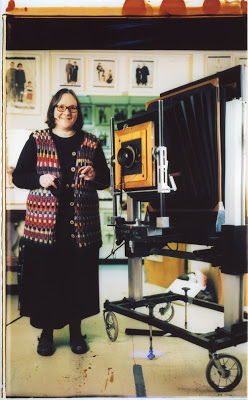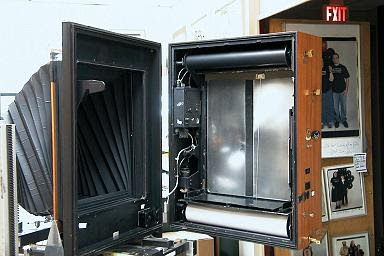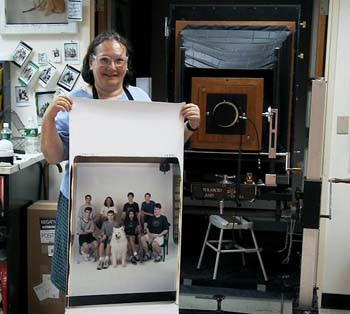Philosophy



 Bob Dylan was in Lowell with the Rolling Thunder Review, and Allen was staying at our house. Harvey (Silverglate) and I went to the concert. I brought my camera. Although the concert folks were very fussy about no cameras, the Dylan people let me bring mine with me. I went into the Dylan green room with Allen. Dylan was wearing light-blue suede boots. He asked me if I knew where Poe was buried. Where he lived in Boston. Alas, I had no idea. He and Allen fooled around for my camera. This image is one of the only images of Allen and Dylan together. It has a total underground life of its own.
Bob Dylan was in Lowell with the Rolling Thunder Review, and Allen was staying at our house. Harvey (Silverglate) and I went to the concert. I brought my camera. Although the concert folks were very fussy about no cameras, the Dylan people let me bring mine with me. I went into the Dylan green room with Allen. Dylan was wearing light-blue suede boots. He asked me if I knew where Poe was buried. Where he lived in Boston. Alas, I had no idea. He and Allen fooled around for my camera. This image is one of the only images of Allen and Dylan together. It has a total underground life of its own.
The hulking dinosaur of a camera that photographer Elsa Dorfman has based her career on for over 30 years could soon become extinct.
Dorfman, now 74 and living in Cambridge, was first introduced to the 20?x24? Polaroid in 1980. She had been invited by the company to try one of the 240-pound behemoths that had originally been built in 1976. Simply referred to by the size of the prints it makes, the 20×24 was like a much larger version of the Polaroid cameras most people were familiar with (the camera and Dorfman are pictured above). It only took a few shots to get her hooked.
“From the minute I used it I loved it,” she says.
She particularly appreciated the physicality of both the camera and the film. The only way to move the heavy, wood-frame beast is on wheels. Once it’s in place, the 5’5? Dorfman opens the back and gets on a stool to see through the focusing screen, adjusting the enormous accordion-like bellows to focus the lens. Focusing takes skill but also a little guessing: The subjects appear upside-down and backwards, and the focusing screen never truly captures the full plane of what appears on the film.
“You just get used to it,” Dorfman says. “By now I think I could walk in an upside-down world.”
Once she has the focus where she likes it, she closes the back and triggers the shutter with a cable release.
All of the film and developing chemicals are stored in the back of the camera. When the lens opens, it exposes a negative. Through a series of buttons and levers, the exposed negative is then sandwiched together with a piece of positive film, and pulled through a set of rollers that apply the developing chemicals and transfer the negative to the positive.
To get the developed picture out of the camera, Dorfman then has to kneel down (or now that she’s 74, sit on a stool) and physically pull it out from the bottom of the developing back and cut the exposure off of the roll.
“It’s sort of like delivering a baby,” she says.
She then waits 90 seconds and peels the old negative off the positive, revealing the final picture.
“There are a lot of steps where you can make mistakes and every picture is like a mechanical miracle,” she says. “The photographer has to be very focused, there is no going back and correcting.”
Because Polaroid only originally made five of these cameras, Dorfman can tell whether a print came from her camera or another, just based on the streaks the developing pods leave behind. She says the film has aged well, but has lost a little bit of the vibrancy and soul it had back in the day.
While Polaroid was still in business, it was relatively easy to find someone who could fix the camera any time it broke. Today, there are only a handful of people who know how to tinker with the finicky creatures. A while back, Dorfman’s regular repair person was busy so she had to beg a furniture maker who was familiar with cameras to help her fix a broken handle that helped open and close the film rollers.
“Everyone who could work on these cameras keeps on dying or moving to Florida,” she says.
Since Polaroid filed for bankruptcy in 2001, the future of their products have been in question. In an attempt to ensure the 20×24 project would live on, in 2007 Dorfman connected her friend Daniel Stern, an investor, with John Reuter, a photographer who ran the 20×24 program for Polaroid. Together the two formed a new company that secured and stored the remaining 20×24 film, found a place to mix the needed chemicals and figured out how to keep making the developing pods.
But even with all this work, there is only enough 20×24 film left for a couple more years. A new company is exploring ways to re-manufacture the giant film, but at the moment there is a finite amount left. A single photo now costs $200 to make.
Like everyone who shot on the handful of 20x24s Polaroids made, Dorfman started by renting the camera. She shot portraits of anyone who would pay her, and slowly her style and aesthetic started to evolve.
“I seem to be the kind of person who doesn’t know where she’s going, but about three quarters of the way there I say, ‘Oh, I’m doing such and such,’” she said. “I would be too afraid to think about [a direction] for fear I would ruin it or that I would be too self conscious.”
After thousands of shots on the giant Polaroid, some of which hang in permanent collections at places like the National Portrait Gallery, and lasting influence in the photo world for her work, Dorfman refuses to categorize herself as a “name.”
“I might be a name to some people, but I’m not a name to myself, or my husband, or my son. I still take out the trash,” she says.
Like Dorfman herself, the photos don’t pull any punches. They’re straightforward portraits that aren’t over-stylized but somehow get to the soul of their subjects.
The poet Robert Creeley (who Dorfman collaborated with on a book) described her work this way: “She is a remarkable reader of people, hears and sees them so unobtrusively that there is no overbearing hand of the artist to contend with, or perversely — to value. Her photos have extraordinary passion for their subjects, but nothing is ever sweetened or blurred.”
Her first book, published in 1974, called Elsa’s Housebook: A Woman’s Photojournal, is a set of portraits and snapshots that document a time of her life as a young, single woman living in Cambridge, Massachusetts.
She was hanging with a well-known crowd that included people like Allen Ginsberg, but the photos don’t attempt to make him, or anyone else out to be more than just her friends. Shot on regular film, the photos are quite intimate but also relatively simple. Often times they’re just snapshots that do nothing more than capture day-to-day life. Dorfman says she’s never had the energy to chase big projects or travel across the world, so a lot of her work is centered around her own life.
While she has slowed slightly, and often becomes bogged down in the mountains of paperwork needed these days to run a photo business, Dorfman says retirement isn’t on the horizon.
“I can’t think that far ahead, to tell you the truth,” she said. “When you’re 30, 40, 50, you can think 10 years ahead. But not me. Retiring would mean putting away my camera. What would I do? The answer is no. I still have so much fun with what I do that it’s almost illegal.”
So much fun, in fact that she can’t imagine stopping for anything. Though her long career has largely been based around an affection for the Polaroid, Dorfman’s love for photography itself is stronger. If the film runs out, she says, maybe she’ll get a digital camera.
 Elsa's housebook: A woman's photojournal
Elsa's housebook: A woman's photojournal
by
Elsa Dorfman
ISBN-10: 0879230991
ISBN-13: 978-0879230999
- Foresight And The "electronicam"
Television network DuMont's Electronicam, used on the The Honeymooners and Captain Video, was a revolution in film recording. Wikipedia... Electronicam was a television recording system that shot an image on film and television at the same time...
- High-speed Photography Going The Way Of Eastman Kodak
Betty Giles with Model 112 camera. "Beloved High-Speed Film Camera Faces Extinction" by Jakob Schiller August 22nd, 2012 Wired For more than five decades, the Charles A. Hulcher Co. filled an important niche in the camera world. Their cameras, which...
- Part Of Eastman Kodak Will Close
I never thought that this would happen, but then I could see the trends: Digital photography and Kodak's film and paper selection greatly diminished over the years. It is a form of classic photography that will be missed by us old timers. "Kodak...
- A Hasselbland Pin Hole Camera
A fine through the lens 2-1/4 X 2-1/4 camera. Pricey and nearly extinct now. "Beautiful Cardboard Hasselblad Almost as Well Made As Real Thing" by Charlie Sorrel March 29th, 2011 Wired Yes, you could make a pinhole camera from a shoebox. In fact,...
- Polaroid Archives
The First Polaroid Model 95A Camera Almost everyone’s heard the story of how Polaroid instant film cameras were born. For nearly a decade before it would create cameras, Polaroid manufactured eyewear, film and plastics. In 1944, Land’s daughter reportedly...
Philosophy
Elsa Dorfman and huge prints


 Bob Dylan was in Lowell with the Rolling Thunder Review, and Allen was staying at our house. Harvey (Silverglate) and I went to the concert. I brought my camera. Although the concert folks were very fussy about no cameras, the Dylan people let me bring mine with me. I went into the Dylan green room with Allen. Dylan was wearing light-blue suede boots. He asked me if I knew where Poe was buried. Where he lived in Boston. Alas, I had no idea. He and Allen fooled around for my camera. This image is one of the only images of Allen and Dylan together. It has a total underground life of its own.
Bob Dylan was in Lowell with the Rolling Thunder Review, and Allen was staying at our house. Harvey (Silverglate) and I went to the concert. I brought my camera. Although the concert folks were very fussy about no cameras, the Dylan people let me bring mine with me. I went into the Dylan green room with Allen. Dylan was wearing light-blue suede boots. He asked me if I knew where Poe was buried. Where he lived in Boston. Alas, I had no idea. He and Allen fooled around for my camera. This image is one of the only images of Allen and Dylan together. It has a total underground life of its own."Gear Behind the Career: Elsa Dorfman and the Giant Polaroid Camera"
by
Jakob Schiller
February 7th, 2012
Wired
by
Jakob Schiller
February 7th, 2012
Wired
The hulking dinosaur of a camera that photographer Elsa Dorfman has based her career on for over 30 years could soon become extinct.
Dorfman, now 74 and living in Cambridge, was first introduced to the 20?x24? Polaroid in 1980. She had been invited by the company to try one of the 240-pound behemoths that had originally been built in 1976. Simply referred to by the size of the prints it makes, the 20×24 was like a much larger version of the Polaroid cameras most people were familiar with (the camera and Dorfman are pictured above). It only took a few shots to get her hooked.
“From the minute I used it I loved it,” she says.
She particularly appreciated the physicality of both the camera and the film. The only way to move the heavy, wood-frame beast is on wheels. Once it’s in place, the 5’5? Dorfman opens the back and gets on a stool to see through the focusing screen, adjusting the enormous accordion-like bellows to focus the lens. Focusing takes skill but also a little guessing: The subjects appear upside-down and backwards, and the focusing screen never truly captures the full plane of what appears on the film.
“You just get used to it,” Dorfman says. “By now I think I could walk in an upside-down world.”
Once she has the focus where she likes it, she closes the back and triggers the shutter with a cable release.
All of the film and developing chemicals are stored in the back of the camera. When the lens opens, it exposes a negative. Through a series of buttons and levers, the exposed negative is then sandwiched together with a piece of positive film, and pulled through a set of rollers that apply the developing chemicals and transfer the negative to the positive.
To get the developed picture out of the camera, Dorfman then has to kneel down (or now that she’s 74, sit on a stool) and physically pull it out from the bottom of the developing back and cut the exposure off of the roll.
“It’s sort of like delivering a baby,” she says.
She then waits 90 seconds and peels the old negative off the positive, revealing the final picture.
“There are a lot of steps where you can make mistakes and every picture is like a mechanical miracle,” she says. “The photographer has to be very focused, there is no going back and correcting.”
Because Polaroid only originally made five of these cameras, Dorfman can tell whether a print came from her camera or another, just based on the streaks the developing pods leave behind. She says the film has aged well, but has lost a little bit of the vibrancy and soul it had back in the day.
While Polaroid was still in business, it was relatively easy to find someone who could fix the camera any time it broke. Today, there are only a handful of people who know how to tinker with the finicky creatures. A while back, Dorfman’s regular repair person was busy so she had to beg a furniture maker who was familiar with cameras to help her fix a broken handle that helped open and close the film rollers.
“Everyone who could work on these cameras keeps on dying or moving to Florida,” she says.
Since Polaroid filed for bankruptcy in 2001, the future of their products have been in question. In an attempt to ensure the 20×24 project would live on, in 2007 Dorfman connected her friend Daniel Stern, an investor, with John Reuter, a photographer who ran the 20×24 program for Polaroid. Together the two formed a new company that secured and stored the remaining 20×24 film, found a place to mix the needed chemicals and figured out how to keep making the developing pods.
But even with all this work, there is only enough 20×24 film left for a couple more years. A new company is exploring ways to re-manufacture the giant film, but at the moment there is a finite amount left. A single photo now costs $200 to make.
Like everyone who shot on the handful of 20x24s Polaroids made, Dorfman started by renting the camera. She shot portraits of anyone who would pay her, and slowly her style and aesthetic started to evolve.
“I seem to be the kind of person who doesn’t know where she’s going, but about three quarters of the way there I say, ‘Oh, I’m doing such and such,’” she said. “I would be too afraid to think about [a direction] for fear I would ruin it or that I would be too self conscious.”
After thousands of shots on the giant Polaroid, some of which hang in permanent collections at places like the National Portrait Gallery, and lasting influence in the photo world for her work, Dorfman refuses to categorize herself as a “name.”
“I might be a name to some people, but I’m not a name to myself, or my husband, or my son. I still take out the trash,” she says.
Like Dorfman herself, the photos don’t pull any punches. They’re straightforward portraits that aren’t over-stylized but somehow get to the soul of their subjects.
The poet Robert Creeley (who Dorfman collaborated with on a book) described her work this way: “She is a remarkable reader of people, hears and sees them so unobtrusively that there is no overbearing hand of the artist to contend with, or perversely — to value. Her photos have extraordinary passion for their subjects, but nothing is ever sweetened or blurred.”
Her first book, published in 1974, called Elsa’s Housebook: A Woman’s Photojournal, is a set of portraits and snapshots that document a time of her life as a young, single woman living in Cambridge, Massachusetts.
She was hanging with a well-known crowd that included people like Allen Ginsberg, but the photos don’t attempt to make him, or anyone else out to be more than just her friends. Shot on regular film, the photos are quite intimate but also relatively simple. Often times they’re just snapshots that do nothing more than capture day-to-day life. Dorfman says she’s never had the energy to chase big projects or travel across the world, so a lot of her work is centered around her own life.
While she has slowed slightly, and often becomes bogged down in the mountains of paperwork needed these days to run a photo business, Dorfman says retirement isn’t on the horizon.
“I can’t think that far ahead, to tell you the truth,” she said. “When you’re 30, 40, 50, you can think 10 years ahead. But not me. Retiring would mean putting away my camera. What would I do? The answer is no. I still have so much fun with what I do that it’s almost illegal.”
So much fun, in fact that she can’t imagine stopping for anything. Though her long career has largely been based around an affection for the Polaroid, Dorfman’s love for photography itself is stronger. If the film runs out, she says, maybe she’ll get a digital camera.
 Elsa's housebook: A woman's photojournal
Elsa's housebook: A woman's photojournal by
Elsa Dorfman
ISBN-10: 0879230991
ISBN-13: 978-0879230999
- Foresight And The "electronicam"
Television network DuMont's Electronicam, used on the The Honeymooners and Captain Video, was a revolution in film recording. Wikipedia... Electronicam was a television recording system that shot an image on film and television at the same time...
- High-speed Photography Going The Way Of Eastman Kodak
Betty Giles with Model 112 camera. "Beloved High-Speed Film Camera Faces Extinction" by Jakob Schiller August 22nd, 2012 Wired For more than five decades, the Charles A. Hulcher Co. filled an important niche in the camera world. Their cameras, which...
- Part Of Eastman Kodak Will Close
I never thought that this would happen, but then I could see the trends: Digital photography and Kodak's film and paper selection greatly diminished over the years. It is a form of classic photography that will be missed by us old timers. "Kodak...
- A Hasselbland Pin Hole Camera
A fine through the lens 2-1/4 X 2-1/4 camera. Pricey and nearly extinct now. "Beautiful Cardboard Hasselblad Almost as Well Made As Real Thing" by Charlie Sorrel March 29th, 2011 Wired Yes, you could make a pinhole camera from a shoebox. In fact,...
- Polaroid Archives
The First Polaroid Model 95A Camera Almost everyone’s heard the story of how Polaroid instant film cameras were born. For nearly a decade before it would create cameras, Polaroid manufactured eyewear, film and plastics. In 1944, Land’s daughter reportedly...
